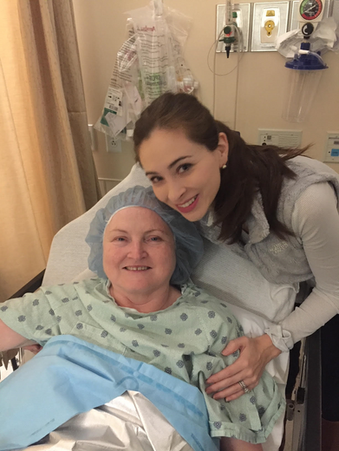Elizabeth was 60 years old before there were any signs of ill-health. Her eyesight deteriorated (she had always had 20/20 vision), she had black outs while sitting at the kitchen table and seemed to just “space out” (we later learned that these were seizures), her legs and ankles became extremely swollen, and her bowels became uncontrolled in the final month leading up to her emergency surgery. The biggest thing though, was her memory. We noticed it starting to decline in 2014, and in 2015 it almost seemed like early on-set dementia. My brother took her to an optometrist to get her vision checked, so she could get glasses and begin driving on her own again. The optometrist rushed out of the examination room and told my brother to get her to a doctor immediately because she saw a mass behind her eyes. We made an appointment with a neurologist a month later in January so her new insurance would kick in. He did an examination and said everything seemed fine. Her memory was fine during his mini-test, it didn’t feel like she had cancer in her stomach or anywhere else he manually checked, but he ordered an MRI anyway to address our concern. The MRI was scheduled a couple weeks after that at 5 PM on a Wednesday, and by the next morning he was calling us with news. We were all together for this phone call. The doctor’s words were frightening. “Whatever you are doing, stop, and head straight to the ER at Memorial City.” My siblings and I jumped in the car and took her to the ER. We waited all day while they did testing, and she stayed overnight. Friday, the results of all the testing were conclusive- she had a brain tumor. The swelling in her brain was so severe that the neurologist began calling neurosurgeons in the TX Medical Center to see who could take her case immediately. So we went to the Med Center by ambulance on Friday, February 5th. The neurosurgeon and other ICU staff examined her, and he said he needed to do emergency brain surgery right away. Since it was Saturday by the time he saw her, he suggested doing the brain surgery Monday morning so he had his full staff. He assured us this was going to be a routine surgery, and that usually patients awake and can communicate within 24 hours. We were happy this thing was getting removed and thought it would “fix” all of the health ailments she was having. Little did we know this was the last weekend with her as she was- she would be forever changed after surgery.
On surgery day, February 8th, we were with her at the hospital. We took pictures and video of her in the pre-op room. She was singing to us, as she so often did. She was happy, unafraid, and trusting God He that would take care of her. We anxiously waited in the waiting room with some of her best friends for the next 8 hours. Finally the surgeon came to tell us we could go see her. My siblings and I rushed to her room in the post-op room and were completely distraught at how we found her. She was shaking convulsively, unconscious, the eye in front of where the mass had been was swollen to a golf ball size, and her head was completely bandaged up. We went to find the neurosurgeon and he said it had gone well, and he was able to get about 75% of the tumor resected. He said she should be awake and talking by the next day. He warned us that her brain fornixes had been flattened so much due to the tumor pushing against them over time, compressing them, that there would be very little short-term memory left, and that we should not expect it to return. That was devastating to us- our mom was an extremely intelligent woman and had always had an impeccable memory. The next day, we came back to the hospital. She did not wake up or start talking. Every day was the same. The neurosurgeons had to install External Ventricular Drains in her ventricles on either side of her brain to drain excess blood and cerebrospinal fluid in hopes that this would help her wake up. They did this after 2 weeks and it seemed to help slightly- she was able to open her eyes for about 30 minutes total per day- but she was unaware of what was going on during those 30 minutes. All throughout every day and night nursing staff in the NICU would poke and prod her to try to get any kind of reaction they could from her. They did this so much that her chest was completely black and blue where they poked and pinched her. It was heart-wrenching. Physical and occupational therapy would come by daily to try to get her to sit up with assistance. She was unable to perform any physical function. However, one day she began responding occasionally to questions by the slightest movement of her thumb. It was almost imperceptible. We were so encouraged by this, and we had so much faith that she was going to get through this because she was a fighter. Finally, the neurosurgeons decided to install a permanent shunt in her brain, with my approval as her medical POA, as this was another surgical operation. Slowly, after the shunt was installed, she would begin to have her eyes open longer and longer during the days, until finally, she was able to sit up with assistance by the therapists. After a month in this minimally conscious state, the neurosurgeon was able to sign off on the order to get her into TIRR for inpatient rehab into the minimally conscious program. We were ecstatic with this progress. Meanwhile, we were meeting daily with the neurosurgeon and neuro oncologist to discuss the tumor, treatment for the remainder of the tumor, her present physical condition and future probabilities, etc. Because the pathologists at Memorial Hermann’s Mischer Neuroscience Institute were unable to identify the tissue, her tumor had been sent off for testing to Foundation Medicine in Massachusetts for further testing. We finally got results 2-3 weeks after the biopsy had been sent off for testing. The results came back with an extremely rare tumor called chordoid glioma, which she had likely had for 1-2 decades. Chordoid gliomas are rare low-grade tumors that arise from the anterior wall of the third ventricle. It is a slow growing tumor, and typically grows for years in females between the age of 30-60. If successfully resected (some patients died during surgery), it causes numerous endocrine and other complications due to its location in the brain near the hypothalamus. This is such a rare tumor that it wasn’t discovered until 1998, and there had only been 60 published cases worldwide on it since then. Her neuro oncologist had been with M.D. Anderson for 10 years prior to the Mischer Neuroscience Institute and told us that he had only seen 3 other cases as rare as this during his tenure there. Because of how she acquired this Traumatic Brain Injury (or TBI), it was shocking to me that more resources weren’t available to identify it quickly and to treat it successfully. After her surgery, she lived in the TIRR inpatient facility for almost 5 months to relearn basic physical functions such as talking, swallowing, brushing her teeth, sitting up, walking, using the bathroom (bedside), etc. We witnessed first-hand the grave effects of a TBI, and when she came home to live with us because insurance had finally ended her stay in TIRR, we had to help her in every physical capacity in our home. She never fully recovered, though she came a long way, during the 13 months she was alive from brain injury to death. She died peacefully in her sleep due to complications from the tumor on March 3rd, 2017.
Further research is imperative. The brain is incomprehensibly complex, and anything traumatic to the brain affects the rest of your body and quality of life. My mission in joining this foundation is to help people with TBI’s, no matter how they were acquired, and to help fund further brain research. It is a way to turn something so destructive in our lives into something positive, and to turn our pain into purpose.
DONATE NOW: https://www.gofundme.com/headstrong-brain-injury-foundation
Written by Haley Culbertson, Vice President of HeadStrong Brain Injury Foundation.































Commentaires